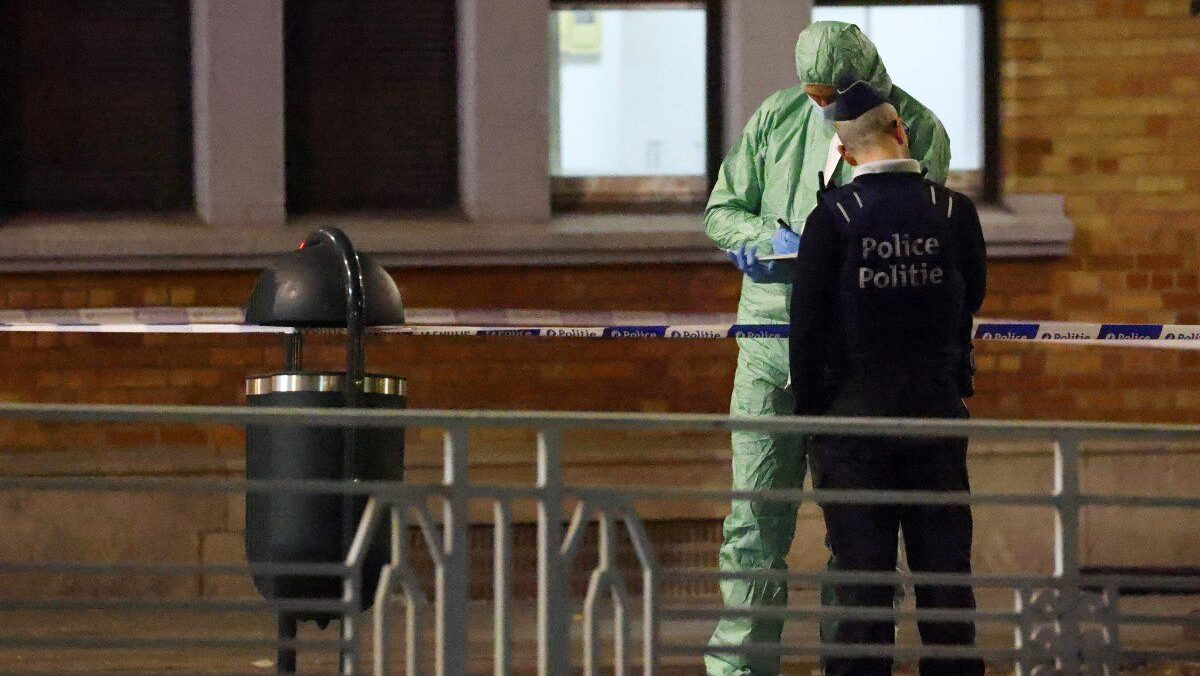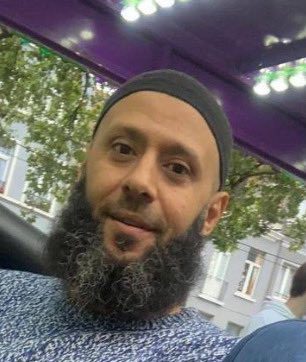
A Belgian police officer and a member of the forensic police stand in a street after the killing of two Swedish men by Islamist terrorist Abdesalem Lassoued on October 16, 2023.
Photo: Kenzo TRIBOUILLARD / AFP
Shots rang out in northern Brussels last week as a Tunisian asylum seeker already convicted of attempted murder in his home country opened fire on Swedish football fans using an AR-15 assault rifle resulting in two fatalities.
A sure sign that Islamist terror has returned to the European capital in force several years after the infamous 2016 bombings on the city’s transport infrastructure, the attack was enabled by a series of policing and asylum-related failures by authorities culminating in the resignation of Belgium’s Justice Minister Vincent Van Quickenborne.

Abdesalem Lassoued—known by his nom de guerre “Abdelsalem Al Jilani”—committed the murders despite multiple security warnings and a deportation against him as he pledged fidelity to the Islamic state in a video he released shortly after the attack.
Arriving in Europe after a 2011 prison break from a Tunisian jail where he had been serving a sentence for attempted murder since 2005, Lassoued subsequently spent the next 12 years bouncing between four different European countries attempting to successfully claim asylum.
Lassoued’s journey is a story of a multitude of failures by European authorities as the continent as a whole struggles to deal with rocketing numbers of asylum seekers.
From a Tunisian prison cell to triggering the resignation of a senior member of the Belgian government, this is the story of Abdesalem Lassoued. Potentially one of many.
2005: Tunisia
Lassoued is sentenced to over 26 years in prison in Tunisia for two counts of attempted murder as well as arson charges. There are unconfirmed reports that Lassoued was also wanted for murder by Tunisian authorities.
January 2011: Italy
After escaping from prison, Lassoued departs from his hometown of Sfax for the Italian island of Lampedusa, one of the primary conduits of illegal migrants into Europe 12 years later, where he claims asylum. Later that month, he is photographed in the Sicilian town of Porto Empedocle before heading north to Turin.
June 2011: Norway
Lassoued appears in Norway where his application for asylum is refused, on the grounds that he was unable to prove a threat of persecution in Tunisia.
2012: Italy
Lassoued is questioned by Italian police in the central city of Terni for a variety of petty offences before making his way to Sweden.
September 2012: Sweden
He arrives in Sweden where he is refused a residency permit. He is subsequently arrested, along with other individuals of migrant background, in a Swedish suburb of Malmö on narcotics charges, including being in possession of 100 grams of cocaine.
2012-2016: Sweden/Italy
Lassoued spends the next two years in Swedish prison, after which he is deported from the country in 2016, barred from returning for ten years. He is sent to Bologna, Italy under the terms of the Dublin Convention which stipulates that asylum seekers apply for asylum in the first country of arrival when they enter the EU.
November 2019: Belgium
Lassoued files his asylum application in Belgium and takes up residence in the northern Brussels commune of Schaerbeek, home to a large Turkish and Arab population. His asylum claim is turned down in October 2020. Authorities in Italy, who had begun to notice growing signs of radicalisation, failed to share that information with Belgian police.
October 2021: Belgium
A deportation order is issued to Lassoued by Belgian authorities—which he ignores.
2022: Belgium
Lassoued is repeatedly spotted at Brussels’ Ahl Allah mosque where he evokes concern from attendees that he is falling into radicalisation and becoming potentially violent. All the while, Lassoued’s deportation process is bureaucratically bogged down.
August 2022: Belgium
The Tunisian embassy contacts Belgian authorities about wanting to expedite Lassoued’s deportation due to murder charges at home. By this time, Lassoued is married to a hairdresser in Brussels.
March-July 2023: Belgium
Continuing to ignore all deportation requests, Lassoued begins posting hostile comments on Facebook about the Swedish Quran burnings, condemning Turkish President Erdoğan for approving Sweden’s NATO application in July 2023. At this time, Lassoued is also accused of assault, stemming from an incident at an asylum centre in Antwerp. The police are unable to track Lassoued down due to him having an unknown address.
7:10 p.m.
Lassoued, dressed in an orange fluorescent jacket and on a scooter, follows a group of Swedish football fans in their taxi on their way to a UEFA qualifier match between Belgium and Sweden at the nearby King Baudouin Stadium. He catches up to them near Place Sainctelette near the suburb of Molenbeek.
7:14 p.m.
Lassoued opens fire on the car full of Swedes, killing two—60-year-old Patrick Lundström and 70-year-old Kent Persson—with another elderly man forced to exit the taxi and flee for his life into a nearby building where he is followed and shot. Footage of the attack shows Lassoued brandishing his automatic weapon screaming “Allahu Akbar” before escaping on the scooter.
8:30 p.m.
A video is posted on Lassoued’s personal Facebook account of him in Arabic claiming the attack in the name of the Islamic State to, in his words, “defend Muslims.”
8:40 p.m.
Lassoued returns to his flat at 94 Avenue Huart Hamoir in north Schaerbeek, a twenty-minute drive from the site of the attack. He is followed home by two Belgian police officers who request permission to intervene. By the time permission is granted, Lassoued has left the house and the officers have lost track of him.
9:55 p.m.
Almost three hours after the initial attack, the Sweden-Belgium game is interrupted at half-time at the request of the Swedish team. Fans are kept confined inside the stadium.
11:30 p.m.
Under armed escort, fans are allowed to leave the stadium. Swedish fans leave the event last and are told to hide their fan colours if possible.
7:30-8:00 a.m.
Undisturbed, Lassoued appears at dawn prayers at his local mosque in Schaerbeek before heading to a local cafe where he is a known regular. A major manhunt is underway throughout the city for him at the time. His presence is reported to police shortly before 8 a.m.
8:15 a.m.
Lassoued is shot by armed police as he tries to escape the cafe and is subsequently taken to the nearby Saint-Luc Hospital. Police recover a bag of clothes and his murder weapon at the cafe.
9:38 a.m.
Lassoued is pronounced dead at the hospital.
4:00 p.m.
The attack is claimed by the Islamic State through the Amaq Press Agency. This is their first European attack since the shooting death of four in November 2020 by an Albanian migrant in Vienna.
October 17th
The Swedish PM Ulf Kristersson flies to Belgium to commemorate the dead warning the EU to clamp down on illegal migration. Media reports first begin to circulate about Lassoued’s failed asylum status and failures by the Belgian police to properly act to apprehend the suspect.
October 19th
A major security alert occurs on a tram line in northern Brussels over sightings of an armed man. This turns out to be a false alarm but results in the area being flooded with police.
October 20th
After days of gradual media revelations about the failure to deport Lassoued, Belgian Justice Minister Vincent Van Quickenborne resigns citing chronic intelligence and policy failures in the handling of the case. Specific concern is expressed about a repeat of the violence due to Friday prayers with the Swedish permanent residence in central Brussels put under 24-hour surveillance.
